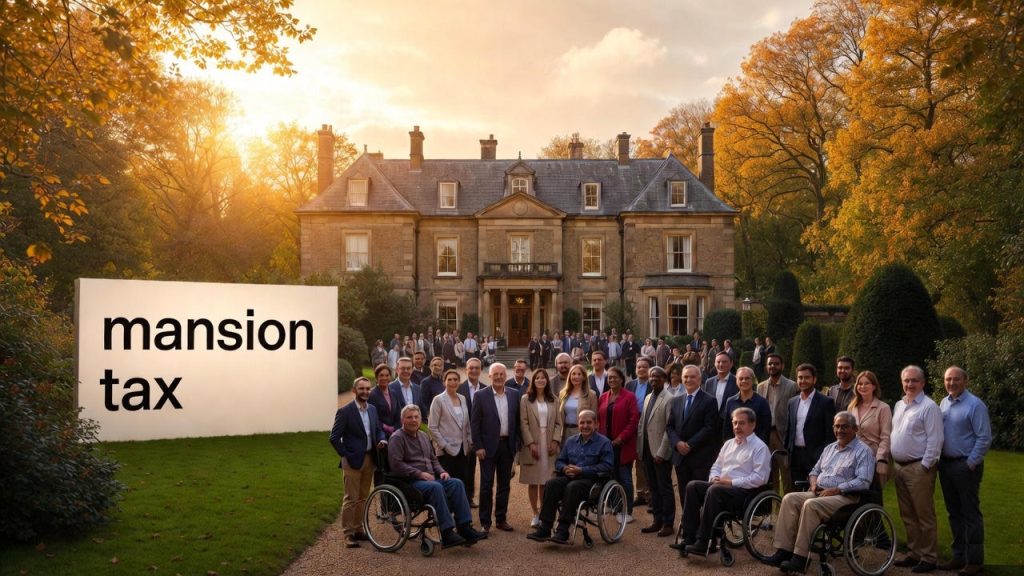As a leading UK-based charity dedicated to supporting underprivileged communities, including those affected by disabilities and economic hardships, UK Narayan Seva Sansthan is committed to keeping our supporters informed about key policy changes that could impact household finances and charitable giving.
Today, we’re diving into the buzzing headlines surrounding Chancellor Rachel Reeves’ proposed “mansion tax” in the upcoming 2025 Budget. This isn’t just policy jargon—it’s a potential shift that could redistribute wealth and influence property markets, affecting everyone from high-net-worth individuals to everyday families aspiring to homeownership.
In this post, we’ll break down the essentials, backed by the latest reports, so you can stay ahead of the curve.
A Quick Refresher: What Exactly is a Mansion Tax?
The concept of a “mansion tax” has floated around UK politics for years, first gaining traction during the 2010s under the Liberal Democrats as a levy on properties valued above a certain threshold—typically £2 million—to fund public services without raising income taxes broadly. It was shelved in 2015 amid coalition government compromises, but the idea resurfaced post-Brexit and during the cost-of-living crisis, with advocates arguing it targets unearned wealth from rising property values. Critics, however, warn it could stifle investment and drive affluent residents abroad.
Unlike a one-off stamp duty, a mansion tax would be an annual charge, often integrated into council tax bands, making it a recurring hit on luxury homes. Proponents see it as progressive taxation; detractors call it a “homes tax” that punishes success. With Labour’s 2024 election victory emphasizing fiscal fairness, this proposal feels timely—especially as public debt lingers and NHS funding gaps widen.
The Latest Scoop: Reeves’ Scaled-Back Plan Takes Shape
In a dramatic pre-Budget leak reported just hours ago, Chancellor Reeves is set to unveil a mansion tax targeting around 100,000 high-value properties worth over £2 million, a significant narrowing from earlier whispers of 300,000 homes above £1.5 million. This adjustment reflects Treasury pragmatism, aiming to avoid alienating too broad a swath of middle-class aspirants while still extracting revenue from the ultra-wealthy.
The levy is projected to generate £400-£450 million annually, funneled toward public services like healthcare and education—areas close to our hearts at Narayan Seva Sansthan, where we rely on stable donor support to aid over 50,000 disabled individuals yearly.
Implementation details point to a clever tweak on existing systems: rather than a standalone tax, it could double council tax rates for Band G (£320,000-£400,000) and Band H (over £400,000) properties, or involve revaluing higher bands to capture true market values frozen since 1991. This avoids the need for a full council tax overhaul, which could cost billions, and targets London’s hotspots where 40% of such properties cluster.
Early modeling suggests the average hit could be £1,000-£3,000 per year per affected household, depending on location and value—modest compared to the £10,000+ some feared, but enough to prompt estate agents to brace for a “prime property price correction.”
(Source: The Independent; The Times)
How Will This Work in Practice? A Step-by-Step Guide
If greenlit in the Autumn Budget—expected imminently—homeowners wouldn’t face immediate chaos. Valuations would likely use HMRC data cross-referenced with Land Registry figures, with appeals processes mirroring current council tax disputes. Exemptions might shield primary residences or those with elderly occupants, though details remain fuzzy. For second-home owners, this layers onto existing surcharges, potentially pushing more sales.
Take a hypothetical £2.5 million London townhouse in Band H: under the doubling proposal, its current £3,500 annual bill could jump to £7,000. That’s a 100% increase, but still dwarfed by the property’s appreciation—many such homes have doubled in value since 2010. For context, the UK boasts about 150,000 properties over £2 million, but only the top tier would qualify, sparing “merely affluent” £1-2 million owners.
This precision is key: it sidesteps the “cliff-edge” pitfalls of broader wealth taxes, like France’s ISF, which saw 60,000 millionaires flee between 2012-2018.
(Source: GB News; Yorkshire Post)
Broader Impacts: Winners, Losers, and Economic Ripples
For the ultra-rich, this is a nudge rather than a shove—yet it signals Labour’s appetite for “taxing the rich” without upending growth. Wealthy expats and non-doms, already eyeing relocation amid inheritance tax hikes, might accelerate moves to Dubai or Switzerland, where property taxes are negligible. Estate agents predict a 5-10% dip in prime sales as sellers preempt hikes, cooling overheated markets in Kensington and Cheshire.
On the flip side, the £450 million windfall could bolster social mobility programs, indirectly aiding charities like ours. Imagine enhanced funding for accessible housing—vital for the 14 million disabled Brits we serve. Lower-income families might benefit from knock-on effects, like stabilized rents if luxury sell-offs flood the market.
However, unintended consequences loom: higher transaction volumes could swell stamp duty receipts short-term, but long-term, it risks entrenching a “two-tier” housing system where aspiration homes edge toward “mansion” status via inflation.
Economists are split. The Institute for Fiscal Studies praises the revenue potential without broad rate hikes, estimating it covers just 0.2% of the £2.5 trillion national debt. But property bodies like Jackson-Stops decry it as “punitive,” warning of deepened regional divides—London’s levy could fund Scottish infrastructure, fueling devolution debates.
(Source: Citywire; Estate Agent Today)
What Should You Do Next? Actionable Advice from Narayan Seva
If you’re a homeowner eyeing this threshold, now’s the time for a valuation check via tools like Zoopla or Rightmove—many properties’ bands lag reality. Consult a tax advisor on mitigation, like gifting assets pre-Budget. Donors to causes like ours: rest assured, this targets wealth hoarders, not philanthropists; in fact, it could amplify giving by freeing public funds.
At UK Narayan Seva Sansthan, we’re monitoring this closely—tax shifts often ripple to charitable ecosystems. Stay tuned for our Budget reaction post.
What are your thoughts? Please share.








